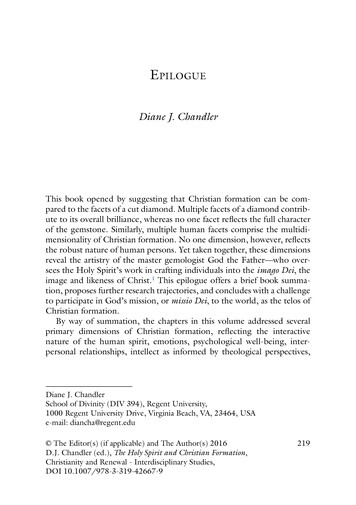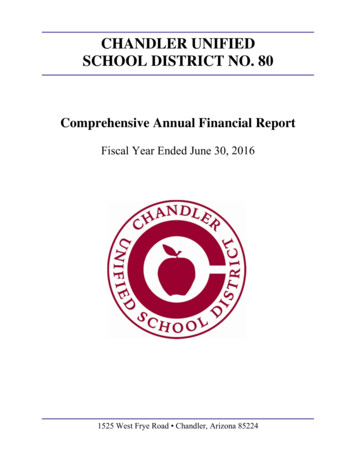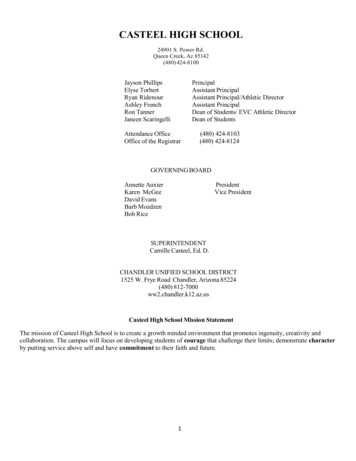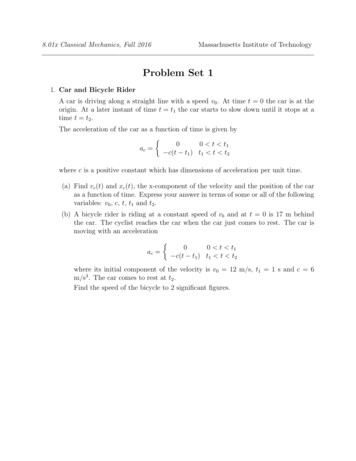
Transcription
EPILOGUEDiane J. ChandlerThis book opened by suggesting that Christian formation can be compared to the facets of a cut diamond. Multiple facets of a diamond contribute to its overall brilliance, whereas no one facet reflects the full characterof the gemstone. Similarly, multiple human facets comprise the multidimensionality of Christian formation. No one dimension, however, reflectsthe robust nature of human persons. Yet taken together, these dimensionsreveal the artistry of the master gemologist God the Father—who oversees the Holy Spirit’s work in crafting individuals into the imago Dei, theimage and likeness of Christ.1 This epilogue offers a brief book summation, proposes further research trajectories, and concludes with a challengeto participate in God’s mission, or missio Dei, to the world, as the telos ofChristian formation.By way of summation, the chapters in this volume addressed severalprimary dimensions of Christian formation, reflecting the interactivenature of the human spirit, emotions, psychological well-being, interpersonal relationships, intellect as informed by theological perspectives,Diane J. ChandlerSchool of Divinity (DIV 394), Regent University,1000 Regent University Drive, Virginia Beach, VA, 23464, USAe-mail: diancha@regent.edu The Editor(s) (if applicable) and The Author(s) 2016D.J. Chandler (ed.), The Holy Spirit and Christian Formation,Christianity and Renewal - Interdisciplinary Studies,DOI 10.1007/978-3-319-42667-9219
220EPILOGUEvocational development, physical health, and ethics. Furthermore, the roleof Scripture intake, sacraments, and even suffering further emphasized theshaping quality of the living Word of God, of communal participation inthe Eucharist, and identification with Christ during seasons of desperation.The Holy Spirit sovereignly interacts through each of these conduits toexpress the richness of God’s redeeming love and mission to individuals,to the church, and to the world. At the same time, God invites cooperativepartnership in the process of Christian formation in non-coercive ways,2as underscored by divine love.3Furthermore, this volume approached Christian formation from a multidisciplinary perspective. That is, various disciplines inform the process ofChristian formation including biblical studies, theology, ethics, philosophy,psychology, counseling and therapy, ecclesiology, physical health sciences,and leadership studies.4 However, other research trajectories, minimallyexplored to date, would further contribute to understanding the gemstone of Christian formation. Hence, I am calling for further explorationregarding the role of culture, family dynamics, gender, age, ethnicity, andprevious church experience to assess their effects on Christian formation.First, one’s cultural milieu exerts multiple influences upon one’s perspective of God, others, and the world. If culture is “human formationat its widest angle,”5 then how does culture influence one’s formationin Christ, considering social norms, value formation, internal and external expectations, and patterns of behavior? James K.A. Smith asserts thatculture powerfully influences what and who we love, and we love whatwe worship based upon specific practices.6 If this is true, then, what influence does social media and technology,7 the arts,8 and entertainment haveon Christian formation? Various authors note the dearth of long-termresearch studies that evaluate the influence of social media on one’s relationship to God.9 More research, therefore, is needed.As it relates the arts and entertainment, experiencing beauty can promptvisceral and transforming effects. For example, engaging in nature, asSaint Francis of Assisi did, can bring one closer to God through appreciating what God has created.10 Even photography can be utilized as aconduit for faith formation and worship.11 For example, Henri Nouwenattributes his sitting before Rembrandt’s painting, The Return of theProdigal at the Hermitage Museum in St. Petersburg, to an encounterwith God and the retrieval of his vocational calling.12 The painting depictsthe parable describing the father’s embrace of his prodigal son who justreturned home (cf. Lu 15:11–32). Viewing this masterpiece gave Nouwen
EPILOGUE221the opportunity to reflect on his life and listen to the voice of the Spirit.Beauty conveyed through visual arts and its relationship to Christian formation deserves further exploration. As James McCullough argues, “It isin attending with ever-greater sensitivity and openness to this communicative dynamic at the heart of art that I maintain spiritual formation canreally take place.”13Music can have a similar effect. For example, consider the role of AfricanAmerican spirituals in the framing of Christian identity for black brothers and sisters.14 Even German theologian Dietrich Bonhoeffer was deeplymoved through gospel spirituals while attending Abyssinian Baptist Churchin Harlem, New York, in 1930. Upon his return to Germany, he wouldplay these spirituals for his students, as they moved the soul toward God.15Second, one’s family greatly influences formation in Christ and requiresfurther inquiry. How do family experiences draw one further into relationship with God, given that the family actually is a refined cultural andrelational facet, where essential role modeling ideally occurs.16 Considerthe influence of Susannah Wesley upon the spiritual development of hersons Charles and John Wesley, along with Monica’s influence upon herson Augustine. Forming of values in the home, along with demonstrationof spiritual practices, establishes faith foundations.Third, the role that gender plays in Christian formation lacks sufficientresearch. What differences exist between men and women relative to theirexperiences of God? Feminist theologians address patriarchal language,values, attitudes, and theological interpretations that exclude women fromfull participation in the home, work, and the church. Is women’s experience of God, however, different from men? If David Murrow is correct inmaintaining that “men are the world’s largest unreached people group”with a “unique culture, language, and way of life,” then how do menexperience God?17 These questions, which deserve further research attention, expose how very little we know about the role of gender as it relatesto Christian formation.Fourth, how chronological age factors into Christian formation isanother facet worthy of further exploration. Although research regardingchildren’s spirituality has increased over the past 25 years,18 what wouldbe important to investigate is their actual encounters with the Spirit andthe ways that children communicate with God and receive communication from God. Is this the same as or different from how teens and adultsexperience the Spirit, and in which ways? Furthermore, adolescents havehopes and dreams but also what Mary Elizabeth Mullino Moore terms
222EPILOGUE“yearnings”—yearnings for the Holy, for community, for understandingthe world, for ethical guidance, and for making a difference in the world.19How do these typical yearnings manifest in Christian formation andspirituality?David Setran highlights how emerging adulthood becomes a criticaltime for developing spiritual capacity, personal identity in Christ, churchengagement, vocational purpose, and morality, including the formationof sexual ethics. Setran notes that spiritual growth against cultural tidesoccurs in “ordinary activities, practices, and interactions of daily life.”20How might this growth be assessed? Further exploration into the nuancesof Christian formation in children, youth, and young adults is needed,given various competitors for young people’s time and attention.Fifth, the influence of one’s ethnicity, closely aligned with culture, likewise contributes to Christian formation. How does being African American,Asian, Latina or Latino, Middle Eastern, European, or Caucasian influenceone’s Christian formation? How ethnic identity within respective churchcultures fosters Christian formation is seldom explored and would be asolid trajectory for further investigation.Sixth, what role does one’s previous and current church experienceplay related to Christian formation in terms of positive and negative experiences? Additionally, how does one’s interaction with ministry leadersinfluence perceptions of and relationship with God? These areas are worthy of further research.Exploring these six facets that contribute to Christian formation willprovide a more robust understanding of the various ways employed by theSpirit to shape believers into the imago Dei. However, simply exploringthe various facets of formation, as worthy as this endeavor is, does not leadto the final telos of why the Spirit desires to permeate every area of life inorder to draw us more deeply into divine love for God and others. Themain telos involves fulfilling God’s missio Dei (Lat. mission of God) to theworld, in which we are challenged to participate (Mt 28:18–20). The ultimate purpose of Christian formation is to become the heart, hands, andfeet of Christ by loving and serving God and others.M. Robert Mulholland reinforces that spiritual formation “is a processof being conformed to the image of Christ for the sake of others.”21 As such,Mulholland attests that the process is holistic and involves corporate andsocial spirituality.22 By its very nature, the process involves incarnate relationships with others in the body of Christ and in the world.23 Or in DallasWillard’s words, the goal is “transforming disciples inwardly, in such a waythat doing the words and deeds of Christ is not the focus but the natural
EPILOGUE223outcome or side effect.”24 Thus, believers are sent into the world, just asJesus was sent into the world by the Father, for the purpose of redeeming sinful and lost humanity (Jn 3:16). This is God’s missio Dei, whichbegins and ends with divine love.25 As influential missiologist David Boschasserts, “there is mission because God loves people.”26 God, therefore, is amissionary God who always reaches out for the sake of others.27Formation in Christ is the starting point of an ongoing life marathon,not the finish line. To participate in the missio Dei means, in MichaelGorman’s words, “to discern what God is up to in the world, and to joinin.”28 Thus, Gorman applies gravitational language used by missiologiststo convey how inward transformation leads to outward mission.29 Theinward journey in God (the centripetal pull toward the center) works intandem with the outward journey of mission (the centrifugal pull awayfrom the center) in an ongoing manner of empowered service to othersby the Spirit. Following Christ as his model, the apostle Paul declaredthat the love of Christ compelled him into the ministry of reconciliationbecause of Christ’s sacrifice (2 Cor 5:14). Likewise, this ministry informsthe church’s mission—to embody Christ’s character as empowered by theHoly Spirit to live in word and deed this message of transforming love.30When considering Christian formation, therefore, the process of beingconformed to the imago Dei in familial, ecclesial, academic, vocational, anddiscipleship contexts, we must resist the temptation to view this processas self-initiated or self-serving. Rather the ultimate purpose of Christianformation is to become more like Christ in order to, in Paul’s words,become ambassadors, as though Christ was making his appeal throughus (2 Cor 5:20) to a lost and dying world. Moreover, the qualificationfor participation in the missio Dei is simple obedience, humility as brokenpeople, and the willingness to walk a path of suffering that Christ himselfmodeled.31 By the power of the Holy Spirit, broken vessels can be used ofGod, such that God alone receives the glory.32 This reality should infuseus with hope, knowing that the Spirit is ever active in outpouring grace forthe Christian formation journey, as the diamond reflects God’s glory morebrightly, in order to fulfill God’s mission in and to the world.NOTES1. See Amos Yong, Who is the Holy Spirit?: A Walk with the Apostles (Boston:Paraclete, 2011).2. See Thomas Jay Oord, The Uncontrolling Love of God: An Open andRelational Account of Providence (Downers Grove, IL: InterVarsityAcademic), esp. 180–86.
224EPILOGUE3. For a pneumatological account on the love of God, see Amos Yong, Spiritof Love: A Trinitarian Theology of Grace (Waco, TX: Baylor UniversityPress, 2012). Also see Kevin J. Vanhoozer, ed., Nothing Greater, NothingBetter: Theological Essays on the Love of God (Grand Rapids, MI: Eerdmans,2001).4. For an excellent multidisciplinary approach on a related topic, see WolfgangVondey, ed., The Holy Spirit and the Christian Life: Historical,Interdisciplinary, and Renewal Perspective (New York: Palgrave Macmillan,2014). Note especially Vondey’s introductory chapter with the focus on“Spiritual Presence as an Interdisciplinary Concern,” 3–7.5. Michael Warren, Faith, Culture, and the Worshiping Community: Shapingthe Practice of the Local Church (Washington, DC: Pastoral Press, 1993), 1.6. James K. A. Smith, Desiring the Kingdom: Worship, Worldview, andCultural Formation (Grand Rapids, MI: Baker Academic, 2009), esp.chapters 3 and 4.7. See Pauline Hope Cheong, Peter Fischer-Nielsen, Stefan Gelfgren, andCharles Ess (eds.), Digital Religion, Social Media and Culture: Perspectives,Practices and Futures (New York: Peter Lang, 2012); Craig Detweiler,iGods: How Technology Shapes our Spiritual and Social Lives (Grand Rapids,MI: Brazos Press, 2013).8. James McCullough, Sense and Spirituality: The Arts and SpiritualFormation (Eugene, OR: Cascade Books, 2015).9. Myron Williams, “Community, Discipleship, and Social Media,” ChristianEducation Journal 12, no. 2 (September 2015), 382; Karen-Marie Yust,“Digital Power: Exploring the Effects of Social Media on Children’sSpirituality, International Journal of Children’s Spirituality, 19, no. 2(May, 2014): 134.10. See Steven Chase, Nature as Spiritual Practice (Grand Rapids, MI:Eerdmans, 2011), 49.11. Eileen D. Crowley, “ ‘Using New Eyes’: Photography as a Spiritual Practicefor Faith Formation and Worship,” Dialog: A Journal of Theology 53, no. 1(March 2014): 30–40.12. Henri Nouwen, The Return of the Prodigal: A Story of Homecoming (NewYork: Image Books, 1994).13. McCullough, Sense and Spirituality, xvii.14. Noel Warner, “African American Spirituals and the Formation of ChristianIdentity,” Encounter 56, no. 3 (Summer, 1995): 271–87.15. Dietrich Bonhoeffer, No Rusty Swords: Letter, Lectures and Notes 1928–1936from Collected Works of Dietrich Bonhoeffer, vol. 1, ed. Edwin H. Robertson,trans. Edwin H. Robertson and John Bowdin (New York: Harper & Row,112–14.16. See Jack O. Balswick and Judith K. Balswick, The Family: A ChristianPerspective on the Contemporary Home (4th ed.) (Grand Rapids, MI: BakerAcademic, 2014).
EPILOGUE22517. David Murrow, Why Men Hate Going to Church (rev. and updated edit.)(Nashville, TN: Thomas Nelson, 2011), xiii.18. See Holly Catterton Allen, ed., Nurturing Children’s Spirituality:Christian Perspectives and Best Practices (Eugene, OR: Cascade Books,2008; Donald Ratcliff, ed., Children’s Spirituality: Christian Perspectives,Research and Applications (Eugene, OR: Cascade Books, 2004); La VerneTolbert, ed. Exploring and Engaging Spirituality for Today’s Children: AHolistic Approach (Eugene, OR: Wipf and Stock, 2014).19. Mary Elizabeth Moore, “Yearnings, Hopes, and Visions: Youth Dreamsand Ministry Futures,” in Mary Elizabeth Moore and Almeda M. Wright,ed., Children, Youth, and Spirituality in a Troubling World (St. Louis,MO: Chalice Press, 2008), 108–22.20. David P. Setran and Chris A. Kiesling, Spiritual Formation in EmergingAdulthood: A Practical Theology for College and Young Adult Ministry(Grand Rapids, MI: Baker Academic, 2013).21. M. Robert Mulholland, Jr., Invitation to a Journey: A Road Map forSpiritual Formation (Downers Grove, IL: InterVarsity Press, 1993), 15.Italics added.22. Ibid., 14.23. Ibid., 17.24. Dallas Willard, Renovation of the Heart: Putting on the Character of Christ(Colorado Springs, CO: NavPress, 2002), 240.25. For a biblical theology of the mission of God, see Christopher J. H.Wright’s tome, The Mission of God: Unlocking the Bible’s Grand Narrative(Downers Grove, IL: InterVarsity Academic, 2006), esp. 62–68, whichpresents a historical perspective on the missio Dei.26. David J. Bosch, Transforming Mission: Paradigm Shifts in theology ofMission (20th anniversary edit.) (Maryknoll, NY: Orbis, 2011), 402.27. Ibid., 400.28. Michael J. Gorman, Elements of Biblical Exegesis: A Basic Guide for Studentsand Ministers (rev. and expanded edit.) (Grand Rapids, MI: BakerAcademic, 2009), 155.29. Michael J. Gorman, Becoming the Gospel: Paul, Participation, and Mission(Grand Rapids, MI: Eerdmans, 2015), 19–20.30. For more on how Christian formation and mission mutually interact, seeKenneth Berding, “At the Intersection of Mission and Spiritual Formationin the Letters of Paul,” Journal of Spiritual Formation and Soul Care 6,no. 1 (2013): 18–27.31. For a presentation on mission with an emphasis on the role of suffering,see Scott W. Sunquist, Understanding Christian Mission: Participation inSuffering and Glory (Grand Rapids, MI: Baker Academic, 2013), esp.168–75.32. Ibid., See Chap. 8 on the essential role of the Holy Spirit. Sunquist notesthat key missiologists have often neglected the Spirit’s role in missionadvance (p. 231, endnote 2).
IndexAAmerican College of Sports Medicine(ACSM), 195Anselm of Canterbury, 3Aquinas, Thomas, 3, 4, 9, 107, 111Archer, Kenneth J., 129, 160n5Aristotle, 9, 107, 110–12Asaph, 175–7attachment theory, 8, 33, 39, 40Augustine, 3, 4, 30, 51, 54, 60, 69,111, 114, 221BBabette’s Feast, 185, 198Baker, Mary Patton, 10, 147–66baptism, 6, 52, 53, 55, 56, 65n18,189, 212baptism of the Spirit, 52Barth, Karl, 3, 4, 9, 127–43Beck, Richard, 39Bekker, Cornelius J. Bekker, 9,91–106Berkhof, Louis, 190Biddy, Wesley Scott, 148, 155blood, 150–2, 154–6, 159, 162n14,162n16, 163n19, 189, 192, 194,196, 197, 217body, 2, 24, 46n27, 54, 70, 99, 136,148, 169, 186, 217, 222. See alsosóma; temple of the Holy Spiritbody of Christ, 2, 6, 12, 28, 136,148–51, 154, 156, 157, 159,160, 188, 222Bonhoeffer, Dietrich, 9, 10, 127–43,170, 177, 221Bosch, David, 223Bouyer, Louis, 98Bowlby, John, 39, 46n34, 47n40Boyce, Kelly Breen, 7, 19–32brain, 3, 158, 192, 196, 197Brand, Paul, 192bread, 10, 99, 147, 149–53, 155, 157,158, 160, 162n16, 163n17,163n18, 164n31, 194brokenness, 6, 168, 169, 173, 175Note: Page numbers with “n” denote notes. The Editor(s) (if applicable) and The Author(s) 2016D.J. Chandler (ed.), The Holy Spirit and Christian Formation,Christianity and Renewal - Interdisciplinary Studies,DOI 10.1007/978-3-319-42667-9227
228INDEXBrunner, Emil, 6, 14n28, 15n38Bucer, Martin, 155Ccalling, 2, 3, 6, 21, 51, 114, 136,160n3, 170, 171, 177, 180, 220Calvin, John, 4, 10, 149, 155–8, 160,161n11, 165n32, 165n34,165n36–9, 165n41, 165n42,166n45cancer, 71, 74, 75, 192–5Chandler, Diane J., 1–15, 95,185–204, 219–25Chan, Simon, 154, 160n5, 164n27character, 1, 2, 4–6, 8–10, 26, 35, 39,42, 49, 57, 63, 73, 80, 83, 93,96, 107–12, 115, 117, 119, 120,121n3–6, 122n8, 122n18, 130,131, 137, 140, 151, 162n17,168, 169, 174–8, 205–18charismatic renewal, 148Chenu, Marie-Dominique, 98,106n80Christlikeness, 2, 4–6, 12, 82, 83church, 3, 23, 36, 51, 81, 91, 120,127, 148, 188, 205, 220cognitive therapy, 28Colbert, Don, 193, 194, 202n55,202n60, 203n67, 203n68,203n74Cole, Graham A., 78, 87n50Communion, 6, 19, 30, 36, 40, 41,43, 148–52, 154–7, 159,162n13, 206, 216, 217. See alsoEucharist; Lord’s SupperCongar, Yves, 98contemplation, 21–4, 31n5, 138conversion, 94, 99, 101, 102cortisol, 196, 197Cranmer, Thomas, 155, 164n31,165n32creation, 3, 4, 6, 12, 20, 26, 42, 43,52, 58, 60, 80, 82, 131, 150,167, 170, 186–8, 190, 200n19,206, 213, 216cross, 4, 10, 77, 79, 131, 152, 153,158, 174, 183n57, 183n58, 187,208, 213, 217crucifixion, 51, 64n14,
School of Divinity (DIV 394) , Regent University , 1000 Regent University Drive , Virginia Beach , VA , 23464 , USA e-mail: diancha@regent.edu . 220 EPILOGUE vocational development, physical health, and ethics. Fur











